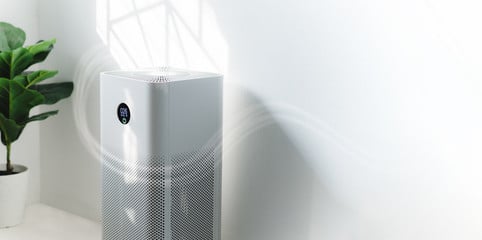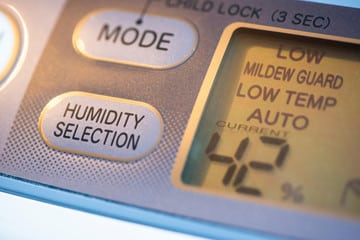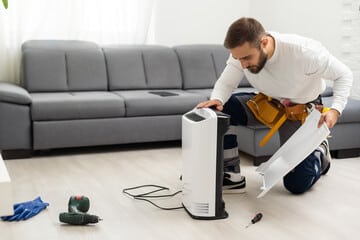You may not realize it, but mold spores can make your home a dangerous environment for your health. So, investing in an ineffective air purifier to remove mold spores can be more frustrating. Choosing the right type of air purifier for mold is vital if you’re looking to get rid of mold, and want to keep your family safe. Fortunately, you can take some simple steps to ensure that you select the best air purifier for your needs.
So, in this article, we’ll discuss the different types of air purifiers, how to identify which type is best for fighting mold in a home, the factors to consider when choosing an air purifier, and tips on researching brands and models. We’ll also explain why it’s important to have a HEPA filter or other advanced filtration system, what kind of warranty customers should look for, and how to test the air quality after installation. Let’s get started!

1. Understand the Different Types of Air Purifiers
There are seven different types of air purifiers that can help you get rid of mold. The most common types include:
- Ultraviolet Air Purifiers
- HEPA Air Purifiers
- Activated Carbon Air Purifiers
- Ionic Air Purifiers
- Electronic Air Cleaners
- Central Air Cleaners
- Air-To-Air Exchangers
Ultraviolet Air Purifiers
Ultraviolet (UV) air purifiers are designed to kill germs, viruses, and bacteria in the air. They use high-energy UV light to create a reaction that destroys microorganisms like mold spores and other allergens. This type of air purifier is often used in commercial buildings, medical facilities, and homes where people have allergies, asthma, or compromised immune systems.
The key benefit of UV air purifiers is that they can reduce the number of mold spores in the air without releasing any ozone byproducts into the environment. Additionally, these purifiers are relatively quiet and low-maintenance since they don’t require filter replacements.
HEPA Air Purifiers
HEPA (High-Efficiency Particulate Air) air purifiers are some of the most popular and effective types of air purifiers. They use a mechanical filter to trap particles as small as 0.3 microns, including mold spores, dust mites, pet dander, smoke, pollen, and other allergens. The best HEPA air purifiers also come with multiple pre-filters to trap larger particles and activated carbon filters that absorb odors and toxic chemicals like formaldehyde.
HEPA air purifiers are effective at removing mold spores from the environment and are well-suited for homes with pets or those with allergies or other respiratory issues. Additionally, they are relatively quiet and require minimal maintenance since the filter only needs to be replaced every 12-24 months.
Activated Carbon Air Purifiers
Activated Carbon air purifiers are designed to absorb odors and harmful toxins like formaldehyde and VOCs. This type of air purifier works by trapping the particles in a filter made of activated carbon, which is a highly porous material that helps trap larger particles while also absorbing odors and toxic chemicals.
Additionally, some carbon-based filters use adsorption to convert VOCs into harmless compounds like water vapor. The key benefit of these air purifiers is that they can effectively remove odors and toxins from the air without producing ozone byproducts. Furthermore, they require minimal maintenance since the filters only need to be replaced once a year or less.
Ionic Air Purifiers
Ionic air purifiers are designed to remove particulates from the air using an electric charge. An ion generator produces charged particles called ions, which attach themselves to dust, pollen, and other airborne particles and make them heavy enough to fall out of the air.
This type of air purifier is highly effective at removing small particles like mold spores from the air, and it can also capture particles that other purifiers may miss. The key benefit of ionic air purifiers is that they are quiet and require minimal maintenance since the filter only needs to be replaced once a year or less.
Electronic Air Cleaners
Electronic air cleaners use an electric current to attract and capture particles from the air. An electric grid creates an electrostatic charge that attracts airborne particles like mold spores, dust mites, and pet dander and traps them in a filter.
This type of air purifier is highly effective at removing tiny particles from the air, and it can capture particles that other cleaners may miss. The key benefit of electronic air cleaners is that they require minimal maintenance since the filter only needs to be replaced once a year or less. Additionally, they are relatively quiet and energy efficient.
Central Air Cleaners
Central air cleaners are installed in the primary HVAC system and can clean the air throughout an entire building. These systems use a combination of filters, such as HEPA filters and activated carbon filters, to capture dust, pollen, mold spores, and other airborne particles from the air.
The key benefit of central air cleaners is that they can provide whole-house coverage and require minimal maintenance since the filters only need to be replaced once a year or less. Additionally, these systems are relatively quiet and energy efficient.
Air-To-Air Exchangers
Air-to-air exchangers, also known as heat recovery ventilators (HRVs) or energy recovery ventilators (ERVs), provide fresh air to the home while simultaneously exhausting stale air outdoors. These systems use a fan and an exchange core to transfer heat between the incoming and outgoing airflow.
The key benefit of these systems is that they can provide fresh air and reduce indoor humidity levels while also reducing energy costs by up to 20%. Additionally, these systems are relatively quiet and require minimal maintenance since the exchange core only needs to be cleaned or replaced every 6 months.
2. Identify What Type Of Air Purifier Is Best For Mold

So, you’ve read tips on researching different types of air purifiers and understanding the benefits of each. Now, it is essential to identify which type of air purifier is best for fighting mold in your home:
- HEPA filters are the best option for eliminating mold spores and dust, pet dander, and other allergens. This type of filter is designed to trap particles within 0.3 microns in size, so it can effectively remove even the tiniest mold spores from your home’s air.
- Activated carbon filters are also recommended for fighting mold, as they absorb odors, chemicals, and airborne particulates. These filters can capture larger particles, making them a good choice for those who suffer from allergies or asthma.
- UV air purifiers are designed to kill microbial contaminants, including mold spores, in the air. They work by exposing the air to ultraviolet light, which disrupts the cell membranes of any microorganisms in the air, disrupting their ability to reproduce and spread.
3. Consider The Factors To Buy Air Purifier For Mold

Before purchasing an air purifier, there are a few factors you should consider:
1) Filter Size
2) Specific Needs
3) Material & MERV Rating
4) Power & Maintenance
5) Air Flow Rate
6) Warranty & Guarantees
7) Cost
Filter Size
The size of your filter is essential when it comes to air purifiers, as the larger the filter, the better it can trap particulates. If you have a large home with high levels of indoor air pollution, then you should opt for a larger filter. On the other hand, if you live in a smaller space or don’t need to capture a large number of contaminants, then a smaller filter size may suffice.
Specific Needs
Before selecting an air purifier, think about your specific needs. Are you looking to address allergies or asthma? Do you need to filter out smoke and odors? If so, make sure the purifier is specifically designed for those needs. Also, keep in mind that some purifiers are more effective at filtering certain types of contaminants than others, so it’s important to do your research before making a purchase.
Material & MERV Rating
The material and MERV rating of an air purifier is also important to consider. The MERV rating measures the filter’s ability to capture particles in the air and ranges from 1 to 16. The higher the rating, the better it will be at capturing contaminants. Additionally, different materials are used to make filters, so look for one that is designed specifically for your needs.
Power & Maintenance
The power of an air purifier is important, as it will determine how quickly and effectively contaminants are removed from the air. Higher wattage units can move more air, capture more particles, and keep your home fresher for longer periods of time. Additionally, you’ll need to consider ongoing maintenance costs for filter changes or cleaning.
Air Flow Rate
The airflow rate of an air purifier is also essential, as it will determine how quickly the device can clean the air. Look for a unit that has a high airflow rate, so you can be sure that your home’s air is being filtered effectively.
Warranty & Guarantees
To ensure that you are getting the most out of your air purifier, it’s important to look for a unit that comes with a good warranty and guarantee. Make sure to read the fine print before purchasing and ensure that you are getting coverage for any repairs or replacements should something go wrong.
Cost
Finally, the cost is an essential factor when choosing an air purifier. While price isn’t always an indicator of quality, it’s important to look for a unit that fits your budget but still offers the features you need. Look for discounts and special deals to get the best value for your money.
4. Research Different Brands And Models To Find One That Fits Your Needs

When it comes to researching different brands and models of air purifiers, there are a few key things to consider. First, check the ratings for each model on sites like Consumer Reports or EPA-approved websites. These reviews will provide detailed information about the quality and effectiveness of each type of air purifier. Additionally, look into customer reviews to get a better sense of how each product actually performs.
You should also research available features, such as noise levels, filter types, and energy efficiency ratings. Additionally, ask questions about maintenance requirements and warranties to ensure you get the best value for your money. It may also be helpful to read up on the latest technology and air purification advances to ensure you get a quality product.
5. Check Customer Reviews To Get An Idea Of How Well The Product Works

When researching an air purifier, it’s also important to read customer reviews to understand better how well the product works.
- Look for comments describing the filtration system’s effectiveness and noise levels.
- Additionally, consider any complaints or issues customers may have experienced with their unit. This will help you determine whether a particular model is worth purchasing.
- Read reviews from different vendors and websites to get a well-rounded perspective on the product.
- Finally, make sure to read any warranty information before making your purchase. This will help ensure that you are getting the coverage and protection you need should something go wrong with the air purifier.
6. Make Sure It Has A HEPA Filter Or Other Advanced Filtration System

When shopping for an air purifier, it’s also essential to make sure that the unit comes with a HEPA filter or other advanced filtration system. This will ensure that the device can effectively capture and remove airborne particles, including mold spores.
Additionally, look for a unit that has multiple different levels of filtration. This will give you the ability to capture different-sized particles, allowing you to customize your home’s air purification.
7. Choose An Air Purifier With A Warranty In Case There Are Any Problems Down The Line

You should also choose an air purifier that comes with a good warranty and guarantee. This will help ensure that you are getting the most out of your purchase and provide coverage for any repairs or replacements should something go wrong. Look for a unit with at least 1 year of coverage, as this is typically enough to cover most issues. Additionally, read the fine print before purchasing and ensure you understand what is covered in case there are any problems. This will give you peace of mind and ensure that your investment is protected should any issues arise.
8. Test Out The Air Quality After Installation To Ensure It’s Working Correctly

Once you’ve chosen an air purifier that meets your needs, testing the air quality after installation is essential. This will help you determine whether the unit is working correctly and providing the desired levels of filtration. Use a home air quality testing device or hire a professional to assess indoor air quality.
Additionally, make sure to regularly maintain your unit and change the filter every 6 months or as recommended by the manufacturer. This will ensure that your air purifier is always working at peak performance and that you are getting the most out of it.
By taking these steps, you can be sure that you’re getting an air purifier
Wrap Up!
In conclusion, choosing the right air purifier to remove mold from your home can be daunting. However, by understanding the different types of air purifiers available, researching different brands and models, reading customer reviews, and choosing a unit with a good warranty and maintenance plan, you can be sure that you are getting the most out of your purchase. Additionally, test the air quality after installation and maintain your unit regularly to ensure it is always working at peak performance.
We hope this article helped guide you on how to choose an air purifier to fight mold in your home. If you want to learn more about how you can improve your air quality, visit our pages now. At AirCleansy, we continuously talk about how to clean air and breathe easier. So, visit now to learn more!

